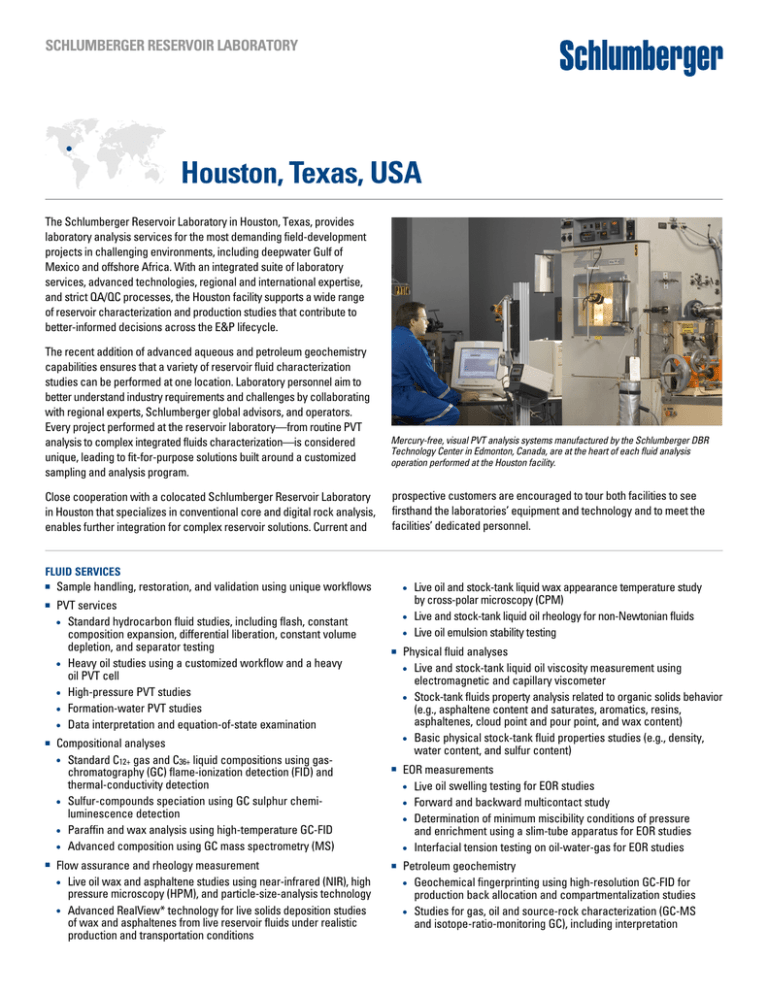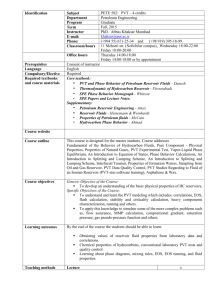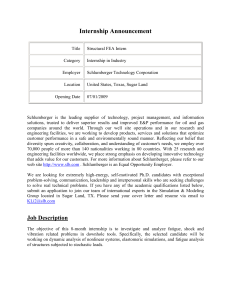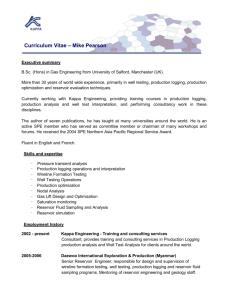
SCHLUMBERGER RESERVOIR LABORATORY
Houston, Texas, USA
The Schlumberger Reservoir Laboratory in Houston, Texas, provides
laboratory analysis services for the most demanding field-development
projects in challenging environments, including deepwater Gulf of
Mexico and offshore Africa. With an integrated suite of laboratory
services, advanced technologies, regional and international expertise,
and strict QA/QC processes, the Houston facility supports a wide range
of reservoir characterization and production studies that contribute to
better-informed decisions across the E&P lifecycle.
The recent addition of advanced aqueous and petroleum geochemistry
capabilities ensures that a variety of reservoir fluid characterization
studies can be performed at one location. Laboratory personnel aim to
better understand industry requirements and challenges by collaborating
with regional experts, Schlumberger global advisors, and operators.
Every project performed at the reservoir laboratory—from routine PVT
analysis to complex integrated fluids characterization—is considered
unique, leading to fit-for-purpose solutions built around a customized
sampling and analysis program.
Close cooperation with a colocated Schlumberger Reservoir Laboratory
in Houston that specializes in conventional core and digital rock analysis,
enables further integration for complex reservoir solutions. Current and
Mercury-free, visual PVT analysis systems manufactured by the Schlumberger DBR
Technology Center in Edmonton, Canada, are at the heart of each fluid analysis
operation performed at the Houston facility.
prospective customers are encouraged to tour both facilities to see
firsthand the laboratories’ equipment and technology and to meet the
facilities’ dedicated personnel.
FLUID SERVICES
■■
■■
■■
■■
Sample handling, restoration, and validation using unique workflows
PVT services
●● Standard hydrocarbon fluid studies, including flash, constant
composition expansion, differential liberation, constant volume
depletion, and separator testing
●● Heavy oil studies using a customized workflow and a heavy
oil PVT cell
●● High-pressure PVT studies
●● Formation-water PVT studies
●● Data interpretation and equation-of-state examination
Compositional analyses
●● Standard C12+ gas and C36+ liquid compositions using gaschromatography (GC) flame-ionization detection (FID) and
thermal‑conductivity detection
●● Sulfur-compounds speciation using GC sulphur chemiluminescence detection
●● Paraffin and wax analysis using high-temperature GC-FID
●● Advanced composition using GC mass spectrometry (MS)
Flow assurance and rheology measurement
●● Live oil wax and asphaltene studies using near-infrared (NIR), high
pressure microscopy (HPM), and particle-size-analysis technology
●● Advanced RealView* technology for live solids deposition studies
of wax and asphaltenes from live reservoir fluids under realistic
production and transportation conditions
●●
●●
●●
■■
■■
■■
Live oil and stock-tank liquid wax appearance temperature study
by cross-polar microscopy (CPM)
Live and stock-tank liquid oil rheology for non-Newtonian fluids
Live oil emulsion stability testing
Physical fluid analyses
●● Live and stock-tank liquid oil viscosity measurement using
electromagnetic and capillary viscometer
●● Stock-tank fluids property analysis related to organic solids behavior
(e.g., asphaltene content and saturates, aromatics, resins,
asphaltenes, cloud point and pour point, and wax content)
●● Basic physical stock-tank fluid properties studies (e.g., density,
water content, and sulfur content)
EOR measurements
●● Live oil swelling testing for EOR studies
●● Forward and backward multicontact study
●● Determination of minimum miscibility conditions of pressure
and enrichment using a slim-tube apparatus for EOR studies
●● Interfacial tension testing on oil-water-gas for EOR studies
Petroleum geochemistry
●● Geochemical fingerprinting using high-resolution GC-FID for
production back allocation and compartmentalization studies
●● Studies for gas, oil and source-rock characterization (GC-MS
and isotope-ratio-monitoring GC), including interpretation
SCHLUMBERGER RESERVOIR LABORATORY: Houston, Texas, USA
■■
Water chemistry
●● Basic water properties (pH, conductivity and resistivity,
gravimetric total dissolved solids [TDS], total suspended solids
[TSS], specific gravity, and total alkalinity)
●● Extended water properties (basic plus Rice alkalinity [OH, HCO2,
CO3], turbidity, free sulfide, and ions by inductively coupled plasma
spectroscopy), including interpretation
●● Live water pH analysis
EQUIPMENT AND TECHNOLOGY
The laboratory operates HPHT equipment designed and manufactured
by the Schlumberger DBR Technology Center in Edmonton, Canada.
Products are continually engineered and added to the list of unique
technologies that provide PVT, flow assurance, and EOR measurement.
Visual, low-volume, H2S‑compliant, and mercury-free PVT cells have
reliably operated for decades, performing thousands of studies. All
compositional laboratory equipment is internationally standardized
and selected from the highest-quality suppliers offering cuttingedge solutions.
■■
■■
■■
■■
■■
■■
■■
NIR solids detection supported by HPM became the industry-standard technique
for assessing reservoir-fluid instability with respect to asphaltene precipitation.
Heavy oil PVT cell with operating range of 15,000 psi [34 MPa] and
482 degF [250 degC]
High-pressure PVT cell with operating range of 25,000 psi [172 MPa]
and 392 degF [200 degC]
Solids-detection systems based on NIR technology with bulk HP
filtration
High-pressure microscopy and cross-polar microscopy (HPM-CPM)
cell with pressures up to 20,000 psi [138 MPa] and 392 degF [200 degC]
RealView technology for unique measurement of organic solids
deposition, including wax and asphaltenes at live conditions
Live water pH system allowing for measurements of single-phase
water pH in 4–9 pH range and calibrated up to 10,000 psi
Accurate evaluation of formation water properties are key to field development.
Sample conditioning systems for up to 60 samples at reservoir
pressure and temperature
The state-of-the art Schlumberger Reservoir Laboratory in Houston delivers accurate
PVT data through representative sampling and secure transfer and handling.
New globally standardized procedures, supported by proprietary QA/QC processes,
ensure the delivery of the highest quality compositional data.
www.slb.com/labs
*Mark of Schlumberger
Copyright © 2014 Schlumberger. All rights reserved. 13-TS-0116





